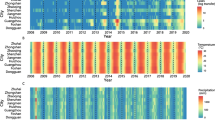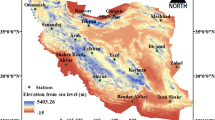Abstract
The dengue infectious disease remnants a human health problem in tropical and subtropical countries. In an Auto Regressive model to assess the role of climatic parameter El Niño Southern Oscillation and land surface mean monthly temperture on dengue outbreaks of the Karachi region over the monthly time interval January 2001 to December 2016, subsequent to stabilization of variance, we are able to apply and predict an Auto Regressive Integrated Moving Average Exogenous-Transfer Function model by using the order selection criteria namely Final Prediction Error and Akaike’s information. The results confirmed that ARIMAX (2,1,2) has fitted model, although an Auto Regressive model predicts a smaller decline in dengue data series than the auto Poisson Regression model. Additionally, we developed an alternative model for the Poisson Autoregressive Exogenous model in order (p) and Negative Binomial Auto Regressive Exogenous model, deliver the best fit as compared to the Poisson Auto Regressive Exogenous model whereas indicated by the deviances. The Pearson test showed a strong positive association between temperature and dengue, while ENSO inverse indication. High dengue outbreaks are detected in the months of September, October, and November. This comparative study exposed a significant relationship among monthly dengue and climatic variation by Auto Regressive Integrated Moving Average Exogenous (ARIMAX), Poisson and Negative-Binomial Autoregressive Exogenous (PARX-NBARX) models, while smallest values of AIC (3.89), Negative Binomial Auto Regressive Exogenous, are preferred more accurate model for the next 12 months forecasting. This study has provided useful information for the development of dengue predictions and future warning systems.







Similar content being viewed by others
References
Abdelrazec A, Gumel AB (2017) Mathematical assessment of the role of temperature and rainfall on mosquito population dynamics. J Math Biol 74(6):1351–1395
Ali M, Iqbal MJ, Sharif M (2013) Relationship between extreme temperature and electricity demand in Pakistan. International Journal of Energy and Environmental Engineering 4(1):36
Arcari P, Tapper N, Pfueller S (2007) Regional variability in relationships between climate and dengue/DHF in Indonesia. Singap J Trop Geogr 28(3):251–272
Aribodor D, Ugwuanyi I, Aribodor O (2016) Challenges to achieving malaria elimination in Nigeria. American Journal of Public Health Research 4(1):38–41
Ahmed SA et al (2015) Analysis of climatic structure with Karachi dengue outbreak. J Basic App Sci 11:544–552
Brunkard JM, Cifuentes E, Rothenberg SJ (2008) Assessing the roles of temperature, precipitation, and ENSO in dengue re-emergence on the Texas-Mexico border region. Salud Publica Mex 50(3):227–234
Cao, Y. (2017). Statistical modelling of mosquito abundance and West Nile virus risk with weather conditions
Dunn PK, Smyth GK (2005) Series evaluation of Tweedie exponential dispersion model densities. Stat Comput 15(4):267–280
Eunice A (2018) Statistical Modeling of Malaria Incidences in Apac District, Uganda, JKUAT
Hii YL, Rocklöv J, Ng N, Tang CS, Pang FY, Sauerborn R (2009) Climate variability and increase in intensity and magnitude of dengue incidence in Singapore. Glob Health Action 2(1):2036
Hilbe JM (2011) Negative binomial regression. Cambridge University Press
Hussain M, Abbas S, Ansari M (2012) Arabian seawater temperature fluctuations in the twentieth century. J Basic App Sci 8(1):105–109
Johansson MA, Cummings DA, Glass GE (2009) Multiyear climate variability and dengue—El Nino southern oscillation, weather, and dengue incidence in Puerto Rico, Mexico, and Thailand: a longitudinal data analysis. PLoS Med 6(11):e1000168
Rahim, H. A., Ibrahim, F., Taib, M., Rahim, R. A., & Sam, Y. M. (2008). Monitoring haemoglobin status in dengue patients using ARMAX model. Paper presented at the Information Technology, 2008. ITSim 2008. International Symposium on
Rampelotto P, Rigozo N, da Rosa M, Prestes A, Frigo E, Echer MS, Nordemann D (2012) Variability of rainfall and temperature (1912–2008) parameters measured from Santa Maria (29° 41′ S, 53° 48′ W) and their connections with ENSO and solar activity. J Atmos Sol Terr Phys 77:152-160
Rusch HL, Perry J (2011) Dengue and the Landscape: a threat to public health. National Center for Case Study Teaching In Science, New York, pp 1–4
Sadiq, B., & Brown, P. (2017). Assessing the Impact of Climatic Variables on Malaria Cases among Pregnant Women in South-Western Nigeria
Sia Su GL (2008) Correlation of climatic factors and dengue incidence in Metro Manila, Philippines. Ambio: A J Hum Environ 37(4):292–294
Sillmann J, Roeckner E (2008) Indices for extreme events in projections of anthropogenic climate change. Clim Chang 86(1–2):83–104
Tian L, Bi Y, Ho SC, Liu W, Liang S, Goggins WB, Chan EYY, Zhou S, Sung JJ (2008) One-year delayed effect of fog on malaria transmission: a time-series analysis in the rain forest area of Mengla County, south-West China. Malar J 7(1):110
Wangdi K, Singhasivanon P, Silawan T, Lawpoolsri S, White NJ, Kaewkungwal J (2010) Development of temporal modelling for forecasting and prediction of malaria infections using time-series and ARIMAX analyses: a case study in endemic districts of Bhutan. Malar J 9(1):251
Zack Guido, 2011, Extreme Events Southwest Climate Change Network, University of Arizona
Zalina MD, Desa MNM, Nguyen V, Kassim AHM (2002) Selecting a probability distribution for extreme rainfall series in Malaysia. Water Sci Technol 45(2):63–68
Zhang X, Zhang T, Pei J, Liu Y, Li X, Medrano-Gracia P (2016) Time series modelling of syphilis incidence in China from 2005 to 2012. PLoS One 11(2):e0149401
Acknowledgments
We thank the dengue survival cells, meteorological department, Karachi and National oceanic and Atmospheric Administration website (www.ncdc.noaa.gov/teleconnections/enso/), for providing the data used in this work. We also thanks sincerely to the Higher Education commission(HEC) for providing the National Research Project for university (NRPU) grants to carry out second author’s PhD research work under the project (NRPU/#20-4039/R&D/HEC/14/697). Three anonymous reviewers and Editor are also thanked for their critical and valuable comments to improve the manuscript as presented. Some results of this study will be part of the Ph.D. thesis of the second author to be submitted at the Mathematical Sciences Research Centre Federal Urdu University Arts, Sciences & Technology, Karachi, Pakistan.
Author information
Authors and Affiliations
Corresponding author
Rights and permissions
About this article
Cite this article
Abbas, S., Ilyas, M. Assessing the impact of EI Niño southern oscillation index and land surface temperature fluctuations on dengue fever outbreaks using ARIMAX(p)-PARX(p)-NBARX(p) models. Arab J Geosci 11, 777 (2018). https://doi.org/10.1007/s12517-018-4119-9
Received:
Accepted:
Published:
DOI: https://doi.org/10.1007/s12517-018-4119-9




